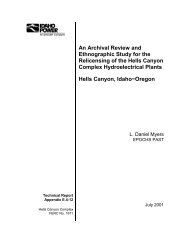Assessment of Chukar and Gray Partridge Populations - Idaho Power
Assessment of Chukar and Gray Partridge Populations - Idaho Power
Assessment of Chukar and Gray Partridge Populations - Idaho Power
- No tags were found...
You also want an ePaper? Increase the reach of your titles
YUMPU automatically turns print PDFs into web optimized ePapers that Google loves.
Hells Canyon <strong>Chukar</strong> <strong>and</strong> <strong>Gray</strong> <strong>Partridge</strong> Report, Ratti <strong>and</strong> Giudice 14gray partridge has 8 recognized subspecies <strong>and</strong> 2 color phases, tending to be browner in the west<strong>and</strong> paler <strong>and</strong> grayer in the east (Carroll 1993). However, a long history <strong>of</strong> introductions <strong>and</strong>game-farm breeding has obscured subspecific taxonomy in North America <strong>and</strong> Europe (Carroll1993). Most populations <strong>of</strong> gray partridge in North America probably belong to P. p. perdix,which has origins in Hungary, Czechoslovakia, <strong>and</strong> Austria (Carroll 1993).4.2. Distribution4.2.1. <strong>Chukar</strong>Native distribution.— Resident in Eurasia from southeastern Europe <strong>and</strong> Asia Minor eastto southern Manchuria, northern China, Turkestan, <strong>and</strong> the western Himalayas (AOU 1998).North America.— Distribution center located in the Great Basin, which includesnortheast California, most <strong>of</strong> Nevada, southeast Oregon, western Utah, <strong>and</strong> a portion <strong>of</strong>southwest <strong>Idaho</strong>. Substantial populations also found in suitable habitat in eastern Utah, western<strong>and</strong> central <strong>Idaho</strong>, northeast Oregon, eastern Washington, <strong>and</strong> portions <strong>of</strong> south-centralCalifornia. Spotty populations occur in western Colorado, southwest <strong>and</strong> north-central Arizona,<strong>and</strong> central, northwest, <strong>and</strong> southeast Montana (Christensen 1996). Birds were also introduced tothe Hawaiian Isl<strong>and</strong>s, but are no longer on Oahu (AOU 1998).<strong>Idaho</strong> <strong>and</strong> Oregon.— <strong>Chukar</strong>s were first introduced into <strong>Idaho</strong> in 1933 in Nez PerceCounty (Salter 1952). Between 1938 <strong>and</strong> 1942, 3,000 chukar partridge were successfullyintroduced into 18-20 counties in <strong>Idaho</strong> (Lever 1987). Twenty-five counties in <strong>Idaho</strong> now haveviable chukar populations (Lindbloom 2000). The first large-scale introduction <strong>of</strong> chukars inOregon occurred in 1952 near John Day River in Gilliam County (Masson 1954). Between 1951<strong>and</strong> 1955, 50,000 chukars were released in Oregon with such success that a hunting season wasestablished in 1956 (Lever 1987). For information on the current distribution <strong>of</strong> chukar in HellsCanyon, see Section 5: On-site <strong>Assessment</strong>, below.4.2.2. <strong>Gray</strong> <strong>Partridge</strong>Native distribution.— Resident in Eurasia from the British Isles, southern Sc<strong>and</strong>inavia,<strong>and</strong> northern Russia south to southern Europe, Turkey, northern Iran, Turkestan, <strong>and</strong> Mongolia(AOU 1998). Perdix is largely sympatric with Alectoris in the Palearctic, although Perdix rangeis slightly farther north <strong>and</strong> includes flatter terrain <strong>and</strong> agricultural l<strong>and</strong>scapes (Watson 1962).North America.— Primary range is the northern plains from northwest Iowa to southernAlberta. Northern limit in aspen parkl<strong>and</strong>s <strong>and</strong> even into boreal forest where cultivated; westernpopulations mostly in agricultural valleys. Small isolated populations in New York, Vermont,Ontario, Quebec, Prince Edward Isl<strong>and</strong>, <strong>and</strong> Nova Scotia (Carroll 1993).<strong>Idaho</strong> <strong>and</strong> Oregon.— Serious efforts to introduce gray partridge in the United Statesbegan in 1900 when 97 birds were released in the Willamette Valley, Oregon (Lever 1987). By1914, gray partridge had been released into 23 counties in Oregon, <strong>and</strong> by 1934 the birds wereestablished over much <strong>of</strong> the eastern part <strong>of</strong> Oregon (Lever 1987). <strong>Gray</strong> partridge first appearedin <strong>Idaho</strong> in the early 1900s. The first birds in <strong>Idaho</strong> probably dispersed from eastern Washingtonafter 1914-16 introductions into Garfield, Spokane, <strong>and</strong> Whitman counties <strong>of</strong> Washington
















